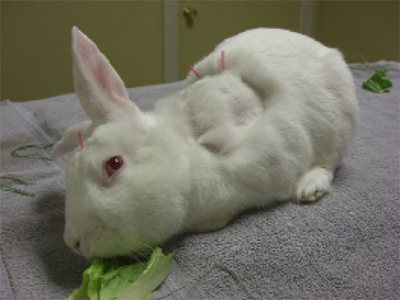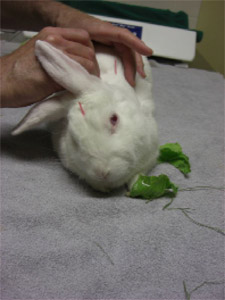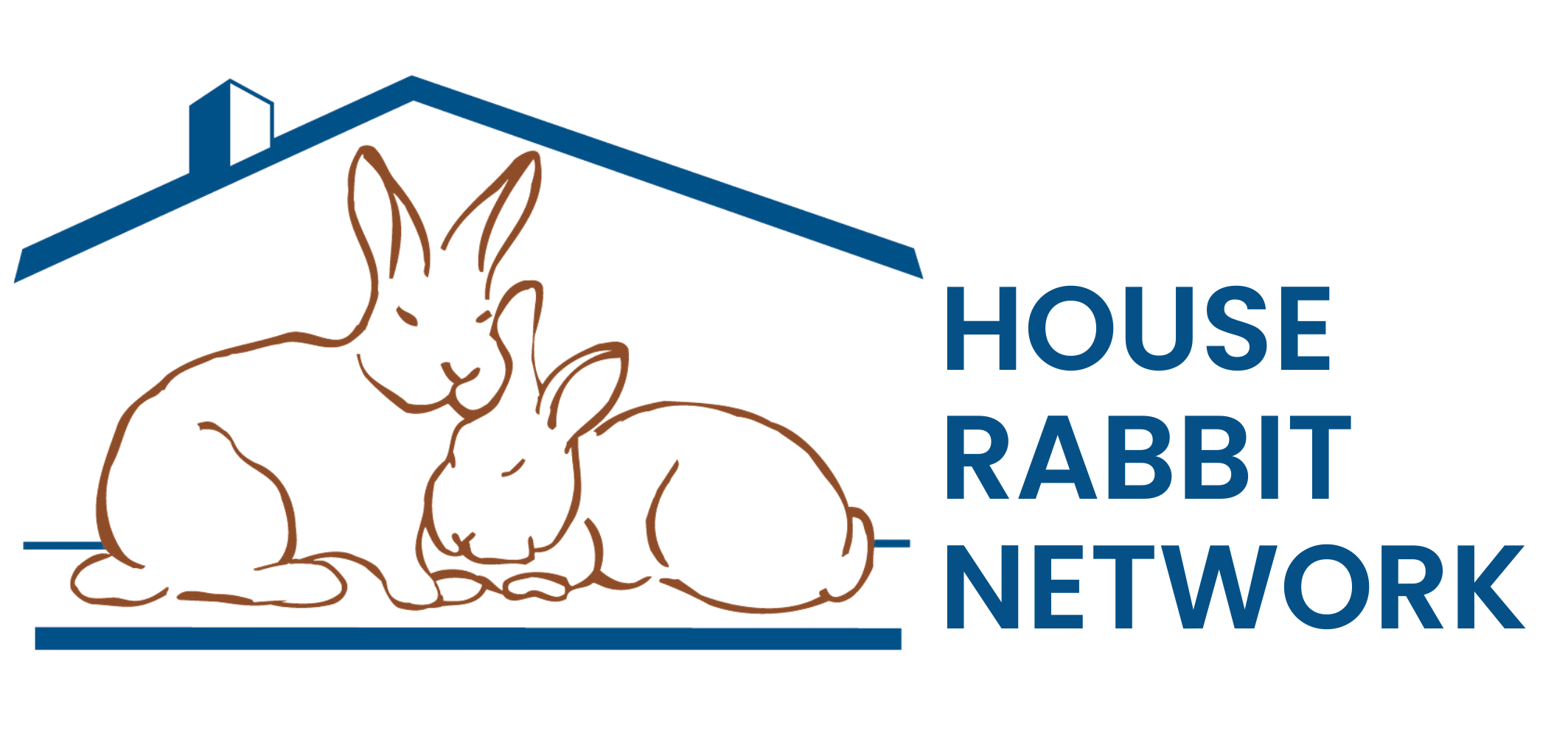Acupuncture for Your Rabbit

Wally, formerly HRN bun Niblet, sits quietly as acupuncture
needles stay put during his first treatment.
Acupuncture has been used for thousands of years to treat a variety of conditions. Both people and animals can benefit from this method of treatment, and your rabbit is no exception! While the majority of traditional acupuncture was originally aimed at treating humans and horses, in the last few decades our small mammals have been recognized as great candidates. As we learn more about the conditions and diseases that affect them, we are finding more conventional medicines and treatments that can assist in their healing. Acupuncture and Chinese herbal medicine can be used in addition to these conventional medicines and treatments.
Acupuncture consists of placing fine, sterile needles into very specific locations on the surface of the body. Acupuncture points are based on the anatomy of the body, and for rabbits, they can be extrapolated from our knowledge of the dog and cat. This treatment modality is most closely associated with ancient China and dates back to at least 2500 B.C. We have adapted this ancient medicine to fit our modern medical needs, but a lot of the theory remains unchanged.
Traditional Chinese medicine is a model for health and disease; it is based around the concepts of Qi, Yin and Yang. Qi was understood as an energy or life force that flows throughout the body, through the internal organs and over the surface of the body. On the surface of the body, the Qi flows in very specific channels or meridians. Acupuncture points located on these meridians can help us access this Qi. Yin and Yang are the two opposite forces of the Universe – dark and light, wet and dry, cold and hot. In a healthy person or animal, Yin and Yang are in balance and both are necessary to exist in order to sustain health. When a person or animal is sick, Qi can be depleted, in excess, blocked or otherwise imbalanced; Yin and Yang can also get out of balance, with one depleted and the other in excess. Using acupuncture, we can help the body achieve its balance again and help it heal itself.
As modern medicine unearths more information about human and animal physiology, we are gaining a better understanding of how acupuncture might work on a cellular level. Research indicates that acupuncture might block pain messages, thus reducing the pain an individual feels as a result of many conditions. It can affect inflammation, blood flow, blood pressure, hormone levels, and more. Ongoing research over the next several years will lead to even more information on how acupuncture “really” works.
Common conditions that are treated with acupuncture in rabbits include arthritis, spondylosis (and other painful conditions), gastrointestinal motility disorders, dry eye syndrome, neurological disease, and palliative care for cancer.
It has been my experience that rabbits tend to tolerate acupuncture well. Since they have high metabolic rates overall, they also tend to respond quickly! I usually recommend 6-8 treatments to determine whether acupuncture is effective for any pet, and weekly treatments to start. We then taper the treatments to determine the longest effective interval.

Wally receiving acuptuncture treatment.
A typical treatment begins with a physical exam, looking at the rabbit from both the conventional and traditional Chinese medical perspectives. Client and acupuncturist discuss what has been happening with the rabbit at home. Needles are placed and treatments usually last anywhere from 5-20 minutes. The client is present the entire time. Needles are withdrawn and the client and rabbit are free to go!
There are very few side effects from acupuncture. Occasionally, a patient will be tired or sore the day following a treatment, but these patients typically rebound by the day after that. They often get a little sleepy or sedate during the treatment itself. Infection is prevented because only sterile, one-use needles are used.
Acupuncture can be an excellent treatment option for your rabbit, either as a stand-alone treatment or, even better, in conjunction with the conventional treatment they are already receiving. We can use knowledge and practice from all areas of the world to keep your rabbit healthy and comfortable. To learn more about veterinary acupuncture or to find a Certified Veterinary Acupuncturist (CVA) near you, visit www.ivas.org or www.aava.org.
©2009 Beth Innis, DVM
